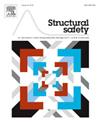Modeling the spatial corrosion of strand and FE-based Monte Carlo simulation for structural performance assessment of deteriorated PC beams
IF 6.3
1区 工程技术
Q1 ENGINEERING, CIVIL
引用次数: 0
Abstract
Structural performance assessments of corroded prestressed concrete (PC) beams using numerical models that account for spatial corrosion distribution and are validated against experimental results remain limited compared to those of reinforced concrete (RC) beams. This study proposes a probabilistic analysis method to evaluate the structural performance of corroded PC beams, incorporating the spatial corrosion distribution of strands and wires. The method is further applied to compare the structural performance of corroded PC and RC beams. Three finite element (FE) models are developed and compared for their accuracy in predicting the structural behavior of PC beams: (a) using the mean steel weight loss of the strand, (b) incorporating the spatial corrosion distribution of the strand, and (c) considering the spatial corrosion distribution of the six outer wires. The model incorporating the spatial corrosion distribution of the six outer wires achieves the highest accuracy, as it effectively simulates the first wire breakage that governs the flexural load-bearing and deflection ductility capacities of PC beams. The probabilistic distribution parameters representing the spatial variability of corrosion are derived from experimental data. Using this distribution, Monte Carlo simulation-based spatial corrosion samples are integrated into the most accurate FE model to obtain the probability density functions (PDFs) of corroded PC beams. The results indicate that PC beams with the same total steel weight loss can exhibit significantly different flexural load-bearing and deflection ductility capacities due to spatial variability, underscoring the importance of a probabilistic assessment. Furthermore, the PDFs of PC members are shifted to the left compared to those of RC members with the same degree of corrosion. Notably, early wire breakage results in lower mean values and standard deviations for the deflection ductility of corroded PC beams compared to RC beams.
钢绞线空间腐蚀建模及基于fe的预应力混凝土劣化梁结构性能评估蒙特卡罗模拟
与钢筋混凝土(RC)梁相比,使用考虑空间腐蚀分布的数值模型对腐蚀预应力混凝土(PC)梁的结构性能进行评估并根据实验结果进行验证仍然有限。本研究提出了一种概率分析方法来评估腐蚀PC梁的结构性能,该方法考虑了钢绞线的空间腐蚀分布。将该方法进一步应用于腐蚀PC和RC梁的结构性能比较。开发了三种有限元(FE)模型,并比较了它们预测PC梁结构行为的准确性:(a)使用钢绞线的平均钢重量损失,(b)结合钢绞线的空间腐蚀分布,以及(c)考虑六条外钢丝的空间腐蚀分布。该模型结合了六根外部钢丝的空间腐蚀分布,达到了最高的精度,因为它有效地模拟了控制PC梁的弯曲承载和挠曲延性能力的第一次钢丝断裂。根据实验数据推导出表征腐蚀空间变异性的概率分布参数。利用这一分布,将基于蒙特卡罗模拟的空间腐蚀样本整合到最精确的有限元模型中,得到PC梁腐蚀的概率密度函数(pdf)。结果表明,相同钢总重量损失的PC梁由于空间变异性而表现出明显不同的弯曲承载和挠曲延性能力,强调了概率评估的重要性。此外,在腐蚀程度相同的情况下,混凝土构件的pdf比混凝土构件的pdf更左移。值得注意的是,与钢筋混凝土梁相比,早期断线导致腐蚀PC梁挠度延性的平均值和标准差更低。
本文章由计算机程序翻译,如有差异,请以英文原文为准。
求助全文
约1分钟内获得全文
求助全文
来源期刊

Structural Safety
工程技术-工程:土木
CiteScore
11.30
自引率
8.60%
发文量
67
审稿时长
53 days
期刊介绍:
Structural Safety is an international journal devoted to integrated risk assessment for a wide range of constructed facilities such as buildings, bridges, earth structures, offshore facilities, dams, lifelines and nuclear structural systems. Its purpose is to foster communication about risk and reliability among technical disciplines involved in design and construction, and to enhance the use of risk management in the constructed environment
 求助内容:
求助内容: 应助结果提醒方式:
应助结果提醒方式:


